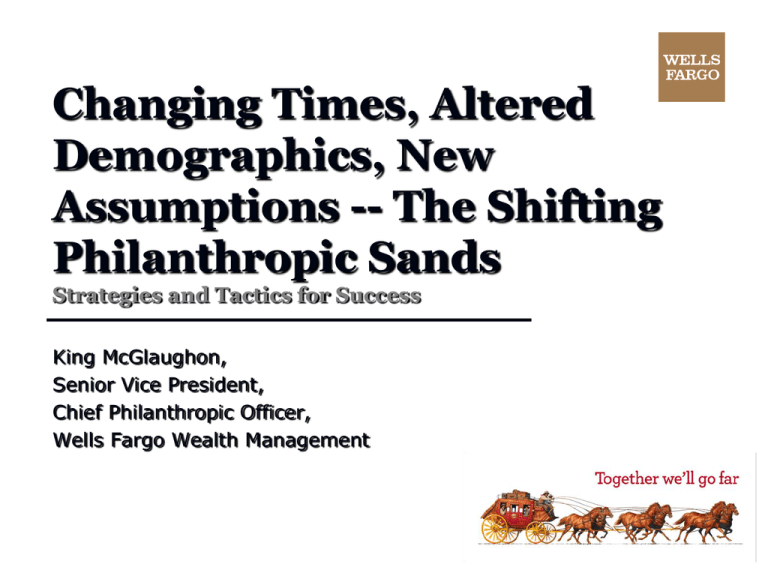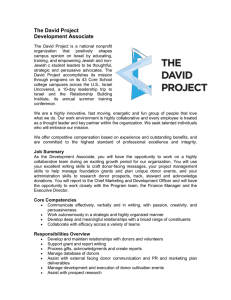Changing Times, Altered Demographics, New Assumptions
advertisement

Changing Times, Altered Demographics, New Assumptions -- The Shifting Philanthropic Sands Strategies and Tactics for Success King McGlaughon, Senior Vice President, Chief Philanthropic Officer, Wells Fargo Wealth Management What is the Environment Today? • • • Increased and evolving regulations, oversight, and potential liability of officers and directors Increasing competition for donors, other funding dollars. Basic capitalization and fiscal challenges at the institutional level • Diminishing endowments and reserves (-30%) • Stresses on federal, state and corporate funding and grantmakers (2010 and forward) Financial stress on individual donors Nonprofits face increasing pressure for accountability and sound management from • Government • Donors New donor demographics Increased use of technology, expansion of the “local community” of nonprofits and donors • • • • • Adoption of UPMIFA in most states by 2009 The Dimensions of Giving in the United States • 80 percent of US households give to charities each year. • • An estimated 75% of all donors (not all donated dollars) receive no tax benefit from their charitable gifts As our wealth increases, the percentage of households that contribute rises markedly • 95% of families with a net worth in excess of $1 million give to charitable organizations annually • 98% of families with a net worth in excess of $5 million give annually 2009 charitable giving Total = $303.75 billion ($ in Billions) Total Giving, 1969–2009 Total Giving, 1969–2009 Millionaire Households (in Millions) 10 9.0 9 8.0 8 7.0 7 6.0 6 5.0 5 4.0 4 3.0 3 2 2.0 1 1.0 0 0.0 198919921995199820012003200420052006 Households Percent of Total Types of recipients of contributions, 2009 Total = $303.75 billion Giving by type of recipient as a percentage of total giving Five-year spans; does not include “unallocated” Data began in 1978 for foundations and in 1987 for environment/animals and international affairs. The number of 501(c)(3) organizations 2000–2009 Total giving by source by five-year spans in inflation-adjusted dollars, 1970–2009 Total giving by source by five-year spans in inflation-adjusted dollars, 1970–2009 Giving by type of recipient Five-year spans, adjusted for inflation Motivation for Increased Giving The Importance of Giving for the Affluent Income Contributed to Charity by the Affluent $5.5 million Amount Contributed Percent of Income $1.5 million $1,000,000 $488,000 $211,000 16.5% 11.6% 3.5% 10.6% $13,113 $10,000 80% 34.5% $65,780 $100,000 100% 90% 57.0% $10,000,000 70% 60% 50% 40% 30% 20% 10% $1,000 0% $1-5 million $5-10 million $10-20 million $20-50 million $50-100 million $100+ million Family Net Worth Source: Boston College - Social Welfare Research Institute & Bankers Trust The Importance of Giving for the Affluent Estate Distribution to Charities by the Affluent 45% 41% 40% 35% 30% 25% 20% 15-16% 15% 10% 8-9% 5% 0% $1-5 million $5-20 million Asset Level Source: Boston College - Social Welfare Research Institute & Bankers Trust $20+ million Philanthropy is one of the top 4 financial issues for UHNW investors Tax Minimization 91% Asset Management 89% Estate Planning Philanthropy 73% 51% Philanthropy is one of the top 4 financial issues for UHNW investors Tax Minimization 91% Asset Management 89% Estate Planning Philanthropy 73% 51% What DOES Matter? – Net Worth What DOES Matter? – Source of Wealth Giving to foundations, 1969–2009 The Boom in Donor-Advised Funds • • Size of Donor Advised Fund Market grew more than 1300% from 1995 to 2007 Proliferation of “commercially sponsored” DAF programs since Fidelity Gift Fund established in 1991 Total Assets $27.7 Billion $24.3 Billion $20.8 Billion $18.8 Billion $17.3 Billion $14.6 Billion $12.3 Billion $10.2 Billion $7.5 Billion $2.4 Billion Source: The Chronicle of Philanthropy Client values that DO affect Philanthropy: • Philanthropic Motivation • Concern about effects of wealth on heirs • Desire to control access to wealth by succeeding generations Preservation of capital Protection of assets from spouses, creditors, etc. • Desire to create a “legacy” • Sense of moral or legal obligation Philanthropic Motivation 79% 80% 69% 63% 70% 50% 46% 60% 50% 29% 40% 11% 30% 4% 20% 2% 10% 0% Desire to support worthwhile causes Meet community's critical needs Set example for children Tax benefits Pressure from peers What Matters? ATTITUDE • “Destin-ators” versus the predestined. • • • • • Wealth builders/creators versus wealth preservers/conservors Change agents Entrepreneurs versus inheritors The secure versus the insecure The “controllers” versus “the controlled” Wealth Recency A Demographic Shift What is the Environment Today? • • • Increased and evolving regulations, oversight, and potential liability of officers and directors Increasing competition for donors, other funding dollars. Basic capitalization and fiscal challenges at the institutional level • Diminishing endowments and reserves (-30%) • Stresses on federal, state and corporate funding and grantmakers (2010 and forward) Financial stress on individual donors New donor demographics Nonprofits face increasing pressure for accountability and sound management from • Government • Donors Increased use of technology, expansion of the “local community” of nonprofits and donors • • • • • Adoption of UPMIFA in most states by 2009 How do we connect with the “Younger Donor”? • • • • • Communication and message strategies Board composition “Control and leadership” opportunities Technology • Invite a group of younger people to view your technology resources – make adjustments • Phone versus tablet versus PC Strategic (planned) giving opportunities Who is the “Younger Donor”? • • Traditional “Donor” was 66+, with planning occurring in the 55-65 year old period “Younger Donor” is 40-55 • • • • • Financially focused Control oriented Planning oriented Expects much from charitable “partners” Has long-range goals and aspirations Perspective of Younger Donors • • • • Longevity: have much longer planning/investment horizons Longer/multiple retirement periods: high retirement income expectations Inflation conscious: need to avoid “erosion” of principal over time Focused on growth, inheritance and creativity Financial Expectations of Younger Donors • • • Growth of income stream over long investment horizon Equal or better performance of “philanthropic assets” relative to “financial assets”--NEVER LESS Frequent, accurate and informative reporting Strategies “Escalating Payment” CRT • Donor creates 5% NICRUT at age 40 • Initial funding with $250,000 • Invests “aggressively” for growth Total return on equities = 11.15% (avg. return on large and small cap equities 1926-1997) Yield on bond allocation = 5.88% (ML 1-10 yr. G/C Index, held to maturity) Yield on S&P 500 = 1.42% (as of 5/26/98) Strategies “Escalating Payment” Income 100,000 90,000 80,000 70,000 60,000 50,000 40,000 30,000 20,000 10,000 0 $88,922 $52,646 r Ye 5 ar 10 Ye ar 15 Ye ar 20 Ye ar 25 Ye ar 30 Ye ar 35 Ye ar 40 Ye a Ye a r1 $27,896 20/80 50/50 80/20 Strategies “Escalating Payment” Principal 7,000,000 6,000,000 $6,167,862 5,000,000 4,000,000 3,000,000 2,000,000 $1,910,057 1,000,000 0 $570,936 r1 ar5 r10 r15 r20 r25 r30 r35 r40 a Ye Ye Yea Yea Yea Yea Yea Yea Yea 20/80 50/50 80/20 Strategies “Escalating Payment” CRT • Income stream never equals 5% payout in aggressive growth investment strategy • Future income not guaranteed--only a projection Strategies: Term CRTs • Phase I: Term CRUT used to grow assets efficiently while producing supplemental income • Phase II: Remainder interest used to create Foundation used as vehicle of “second career” interests and goals Strategies: Closely-Held Business CRTs • C-Corp shares to CRT to ESOP • QRP (after ESOP funding) to CRT • CRT/Stock Redemption to “move” closely-held business to next generation Strategies: Lifetime Foundations and SOs • Use to create income tax shelter through gifts of appreciated assets resulting in income tax charitable deductions with 5-year carry forward • Build and operate a strategic foundation during productive years, affecting change and creating leadership role in community The Current Market Environment The Current Regulatory Environment Changes in overall federal tax regime •2010 as year of “no transfer tax” (maybe) •2011 as year of “reversion to ‘old transfer tax’” (maybe) – the “stepped-up basis” conundrum •Projected increases in Income Tax (and Capital Gains Tax) rates •Interest in income tax deductions will increase as tax rates climb, especially capital gains rates (collectibles currently at 28%) Changes in overall “charitable giving” infrastructure • Gifts from IRAs and other “tax-benefitted” tools • Supporting organization, private foundation, large public charity, and donor-advised fund proposals The Current Market Environment CRTs are excellent asset management tools •Tax free asset management zone (increases “real” net total return on investments) •Ability to move around in market without concern for realization of gains in portfolio •Creates cash flow through Income Tax Deduction, conversion of dividends a/o interest into income stream based on total value •Ability to control taxability of income stream through changes in asset allocation •Interest will increase as tax rates climb, especially capital gains rates (collectibles currently at 28%) The Current Market Environment The “Fearful Investor” •Has become “risk averse” •Wants to bail out into fixed income assets •Wants economic security in erratic market Use a CRAT to create a “fixed income asset” from equities. Consider a “Megannuity” The Current Market Environment “Not-readily Marketable” Assets (Generally unaffected by stock market declines; may rise in down markets; may experience increasing values as “safe harbor” for uninvested assets) The Current Market Environment “CLTs: Leverage Market Down-Turns” • Historically low effective rates allow maximum planning leverage for CLTs Strong stocks that have lost value Client intends to hold Deflated value makes for optimal CLT funding, all “bounce back” occurs outside donor’s taxable estate • Leverage the Market AND the lifetime estate/gift tax exemptions/exclusions Advisors and Giving What Donors Want in Their Charitable Advisor Planned-giving officers Professional advisors 16.0% 97.9% Skill and efficiency in working with the donor's professional advisers or with the charity 60.3 75.2 Willingness to let the donor set the pace in the planned-giving process 67.2 86.0 Help in deciding what type of planned gift to make 85.5 96.8 Knowledge about the advantages and disadvantages of each type of planned gift 94.7 99.4 Sophisticated understanding of the donor's personal motivations to give 99.2 82.2 Effectiveness in getting the charity to treat the donor as he or she wants to be treated 69.5 11.2 Expertise in the technical details of executing the planned gift Note: 603 donors surveyed.* Donors in the survey had made planned gifts worth at least $75,000 and had a net worth of $5-million or more. Source: Prince & Associates and Private Wealth Consultants





